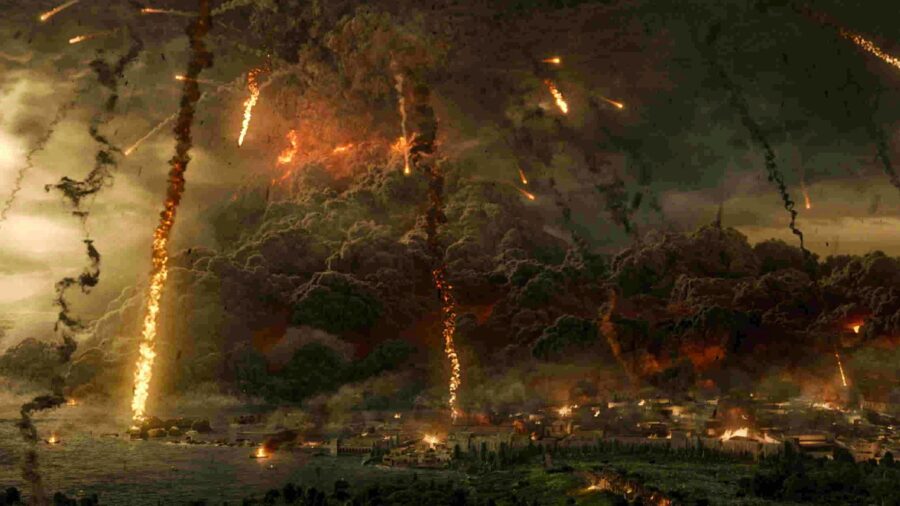AI Reads Volcanic Scroll In Game-Changing First

21-year-old Luke Farritor, a computer science student at the University of Nebraska-Lincoln, has just achieved a significant milestone in technology advancement. According to Scientific American, Farritor created an AI designed to read the Greek letters on an ancient manuscript buried under volcanic ash during the eruption of Mount Vesuvius in AD 27, the same catastrophe that engulfed the nearby city of Pompeii. Farritor created the AI in an effort to win the Vesuvius Challenge, a global contest aiming to decode the ancient texts hidden within carbonized scrolls from the Roman city of Herculaneum.
University of Nebraska-Lincoln computer science student used an AI algorithm to decode an ancient scroll from the city of Pompeii.
Farritor’s pioneering algorithm, designed to recognize minute differences in surface texture, successfully highlighted Greek letters, including the word “πορϕυρας” (porphyras), meaning “purple.” His innovative approach to training a neural network through AI and illuminating ink on the scrolls has led to the astounding discovery.
Federica Nicolardi, a papyrologist at the University of Naples and a member of the academic committee responsible for reviewing Farritor’s findings, described the moment she saw the AI read the first images on the scroll as a dream come true. These scrolls have previously been a challenge to read due to their crumpled and crushed state caused by being buried beneath 20 meters of volcanic ash.
The advancement of AI technology in deciphering unreadable texts like this scroll has raised hopes and excitement among historians and archaeologists alike.
The Vesuvius Challenge, a global competition offering a series of awards, including a substantial $700,000 grand prize for reading four or more passages from a rolled-up scroll, declared Luke Farritor as the winner of the ‘first letters’ prize, awarding him $40,000 for his AI deciphering more than ten characters on the scroll within a 4-square-centimeter section of papyrus. Youssef Nader, a graduate student at the Free University of Berlin, secured the second place with a $10,000 prize.

The advancement of AI technology in deciphering unreadable texts like this scroll has raised hopes and excitement among historians and archaeologists alike. The scrolls, initially discovered in the 18th century within a luxury villa believed to be associated with Julius Caesar’s father-in-law, offer an unparalleled opportunity to shed light on ancient history and literature. Unlike classical texts that have been repeatedly copied over centuries, the Herculaneum library may contain works directly from the authors, providing insights into Greco-Roman culture.
Until this AI was created, scholars could only study opened fragments on the scrolls, revealing predominantly Greek texts related to the Epicurean school of philosophy. However, more than 600 scrolls, most of which are housed in the National Library in Naples, remain unopened and intact.
Brent Seales, a computer scientist instrumental in setting up the Vesuvius Challenge, and his team have invested years in developing methods to virtually unveil the thin layers of these scrolls using X-ray computed tomography (CT) scans. However, one major hurdle was that the carbon-based ink used on the Herculaneum scrolls was invisible on CT scans. Seales realized that subtle texture differences on the papyrus surface could be captured by CT scans, meaning the AI could distinguish and read these small differences on the scrolls.
Until this AI was created, scholars could only study opened fragments on the scrolls, revealing predominantly Greek texts related to the Epicurean school of philosophy.
Seales and his team subsequently released all their scans and code to the public, launching the Vesuvius Challenge to expedite the process of deciphering these ancient texts. The competition attracted around 1,500 teams collaborating on Discord. As each milestone was reached, winning code was made available for others to build upon, enabling a crowd-sourced AI approach to unravel the scrolls.
As the competition progresses towards the grand prize deadline on December 31st, the atmosphere is charged with “unbridled optimism.” Farritor and other contestants continue to run their AI models on other segments of the scroll, unveiling more characters and potentially rewriting the history of the ancient Roman world.












